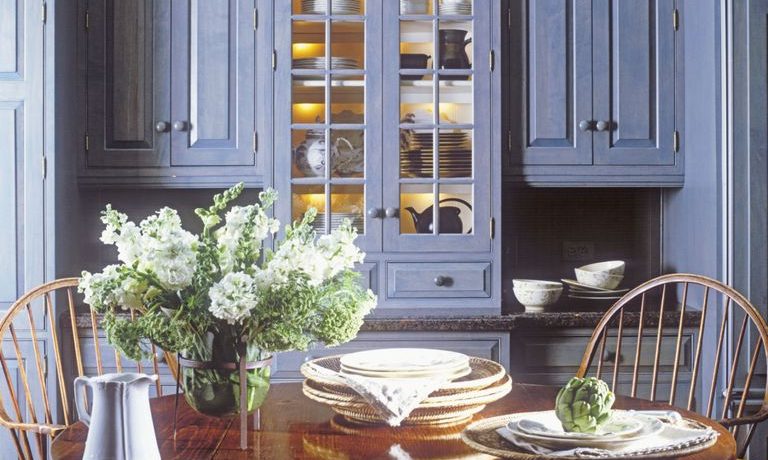Painted cabinets are ruling Pinterest these days, since intrepid DIYers love the idea of updating their kitchens with only a few coats of a new color. It seems like a no-brainer project, but this undertaking actually has many potential pitfalls. Avoid these blunders to end up with cabinets you can’t wait to show off:
1. You have unrealistic expectations.
Painted cabinets look lovely, but they aren’t going to look totally smooth. “If the cabinets have a visible open grain, the grooves are going to show through the paint,” warns Don Fahrbach, president of professional painting company PNP Craftsmen in New York City. “Even if it wasn’t super obvious when the wood was just stained, it’s going to be more evident once the paint dries.” You can fill the grain with putty, but that can be time-intensive and challenging to get just right.
2. You don’t allow yourself enough time.
“This isn’t a lazy Sunday project,” says Sherry Petersik, who, along with her husband, chronicled kitchen painting projects on her popular blog Young House Love. She says people often think it’s a weekend job, but it takes at least four to seven days when you build in the proper prep time (and snack breaks, of course).
3. You don’t clean the wood.
“No matter how clean you think your kitchen is, you need to wipe everything down with a grease remover,” says Fahrbach. Otherwise, when you add a water-based paint to an oil-covered door, the paint won’t stick. He recommends a paint-prep degreaser called TSP.
4. You don’t remove the doors off and drawers.
This is a crucial first step: Take all the doors off, pull the drawers out and remove the hardware knobs and hinges. Some people try to save time by painting everything — hinges and all — while they’re still in place, but Petersik warns that it’s not a long-term fix. “Your cabinets and hardware will start to chip and show signs of wear within a month — or even immediately.” Once the paint on the hinges starts to crack, all you can do is sand everything down and soak the hardware to remove the paint, so save yourself the aggravation.
5. You skip labeling where your doors, drawers and hardware go.
Because what once was hung up will need to go back in the same place, it’s worth using numbered labels to help you remember where everything goes. A piece of masking tape stuck to the back of each piece will do just fine.
6. You skip sanding.
Even if your cabinets are in near perfect condition, you still have to sand them so the paint will stick. Use sandpaper in the middle of the spectrum (150 or 200 grit is good) and just give all of the surfaces a quick buffing. “You’re not trying to get down to the bare wood,” says Petersik. “You just want to take the surface from glossy to matte.”
7. Your surface isn’t dust-free before you paint.
Vacuum up any debris before you even think of dipping that brush in paint. Just a few pieces of dust can ruin the look: “You’ll get a gritty finish and it’ll look like you painted over sand,” says Fahrbach. “To fix it, you’ll have to sand it and repaint it all over again.”
8. You don’t prime.
It’s tempting to skip this step, but consider this: “Your finished kitchen could look amazing then, three weeks or three months later, knots in the wood can start to bleed through your paint,” warns Petersik. Use a stain-blocking primer (she likes Kilz Clean Start), and you won’t get surprise blotches as the paint cures.
9. You pick the wrong color.
Of course, there’s no right or wrong color for your own kitchen. But for cabinets, it’s important you get it right the first time: “This project is easy but it’s not the kind of job you’re going to want to redo any time soon if you don’t like the color,” says Petersik. She suggests painting a big poster board with a tester can in the color you’re considering (you can usually get a small one for just $5). “Hang it up next to your backsplash and your appliances and make sure that’s really the color you want.”
10. You choose cheap paint.
Petersik has tried all sorts of paint and she’s had the best results from Benjamin Moore Advance. At around $53 a gallon, it’s certainly more expensive than other brands, but Petersik says it’s worth it. “You get a smoother finish with a good paint,” she says. Most kitchens need less than two gallons, so the splurge isn’t going to break the budget (plus you’re skipping hiring a pro, so treat your amateur skills to the best, easiest-to-use materials).
Worried about visible brush marks? Virginia at Live Love DIY follows her brush strokes with a foam roller to smooth things out. And a more experienced DIYer might like the finish provided by a spray gun (like Jenny at Little Green Notebook uses), but it’s a bit more unwieldy than a brush.
11. You rush to put cabinets back.
Yes, it’s super annoying to wait days for paint to cure. But if you accidentally smudge the paint, you have to sand the door and repaint it (a hard truth any woman who’s rushed to leave the nail salon surely understands). “As much as it kills me to stare at the doors on the floor drying, I’d much rather wait than jump the gun,” Petersik says.
All rights reserved to the initial publisher for Good Housekeeping
Collected and published by Arms &McGregor International Realty® editorial team. Get in touch with us at [email protected]

